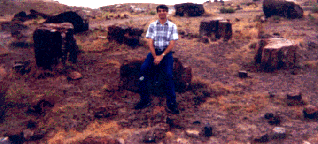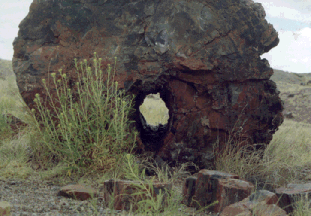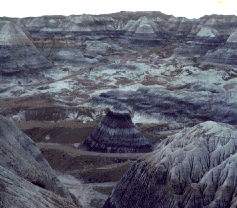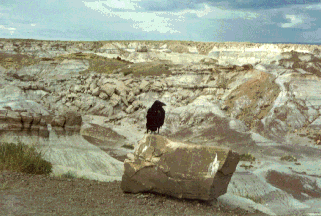
The Petrified Forest

 This
high dry tableland was once a vast floodplain crossed by many
streams. To the south, tall, stately pine-like trees grew along
the headwaters. Crocodile-like reptiles; giant, fish-eating amphibians;
and small dinosaurs lived among a variety of ferns, cycads, and
other plants and animals that are known only as fossils today.
The tall trees-Araucarioxylon, Woodworthia and Schilderia-fell
and were washed by swollen streams into the floodplain. There
they were covered by silt, mud, and volcanic ash, and this blanket
of deposits cut off oxygen and slowed the logs' decay. Gradually
silica bearing ground waters seeped through the logs, and bit
by bit, encased the original wood tissues with silica deposits.
Slowly the process continued, the silica crystallized into the
quartz, and the logs were preserved as petrified wood.
This
high dry tableland was once a vast floodplain crossed by many
streams. To the south, tall, stately pine-like trees grew along
the headwaters. Crocodile-like reptiles; giant, fish-eating amphibians;
and small dinosaurs lived among a variety of ferns, cycads, and
other plants and animals that are known only as fossils today.
The tall trees-Araucarioxylon, Woodworthia and Schilderia-fell
and were washed by swollen streams into the floodplain. There
they were covered by silt, mud, and volcanic ash, and this blanket
of deposits cut off oxygen and slowed the logs' decay. Gradually
silica bearing ground waters seeped through the logs, and bit
by bit, encased the original wood tissues with silica deposits.
Slowly the process continued, the silica crystallized into the
quartz, and the logs were preserved as petrified wood.
That was about 225 million years ago in the late Triassic. After
that time, the area sank, was flooded, and was covered with freshwater
sediments. Later the area was lifted far above sea level and this
uplift created stresses that cracked the giant logs. Still later,
in recent geological time, wind and water wore away the gradually
accumulated layers of hardened sediments. Now the petrified logs
and fossilized animal and plant remains are exposed on the land's
surface and the Painted Desert has its present sculpted form.
Today the ever present forces of wind and water continue to remove
sediments. Erosion continues to break down the giant logs and
reach for the logs and other remaining fossils still buried below
the surface. In some places, up to 90 meters (300 feet) of fossil-bearing
material remains. The petrified logs, the other fossils of plants
and creatures that lived in the area, and the rocks locking them
in place all testify to changes in the environment through millions
of years.
But there are other stories here; that of man is readily seen
on the landscape. Sites throughout the park tell of human history
in the area for more than 2,000 years. We don't know the entire
story, but there were separate occupations, a cultural transition
from wandering families to settled agricultural villages-pueblos-and
trading ties with neighboring vil lages. Then this story of early
people, told by potsherds, rubble, and pictures on the rocks,
fades about 1400 A.D.
 In the mid-1800s U.S.
Army mappers and surveyors came into this area and carried back
East stories of the remarkable "Painted Desert and its trees
turned to stone." Next, farmers, ranchers, and sightseers
made their ways into the area. After a period of using the wood
for souvenirs and numerous commercial ventures, territorial residents
recog nized that the supply of petrified wood was not endless.
In 1906 selected "forests" were set aside as Petrified
Forest National Monument.
In the mid-1800s U.S.
Army mappers and surveyors came into this area and carried back
East stories of the remarkable "Painted Desert and its trees
turned to stone." Next, farmers, ranchers, and sightseers
made their ways into the area. After a period of using the wood
for souvenirs and numerous commercial ventures, territorial residents
recog nized that the supply of petrified wood was not endless.
In 1906 selected "forests" were set aside as Petrified
Forest National Monument.
In 1932 some 1,000 hectares (2,500 acres) more of the Painted
Desert were purchased and added to the monu ment. In 1962 the
area became Petrified Forest National Park, and in 1970, 20,250
hectares (50,000 acres) were further set aside as wilderness.
Research continues to unlock the geological and human stories of this area set aside for present and future genera tions. And today the story of our passing is added to the history of Petrified Forest National Park.
 From
the west take U.S. 180 from Holbrook to south entrance
of the Petrifed Forest National Park; drive through the park;
rejoin I-40 at the north entrance.
From
the west take U.S. 180 from Holbrook to south entrance
of the Petrifed Forest National Park; drive through the park;
rejoin I-40 at the north entrance.
From the east, leave I-40 at the north entrance; exit at
south on U.S. 180 to I-40 at Holbrook.
There are no campgrounds in the park. Only wilderness backpack
camping is allowed. Obtain the required free permit at a visitor's
center. Picnic areas are at Chinde Point and Rainbow Forest. There
is a restaurant, service station and gift shop in the Painted
Desert. In the Rainbow Forest, find fountain and gift shop.
The National Park Service administers the park. The superintendent's
office is in the Painted Desert Visitor Center. The address is
Petrified Forest National Park, Arizona, 86028.